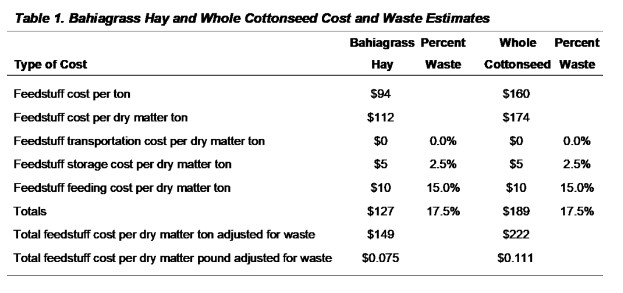By Chris Prevatt
While the memories of the 2018-2019 winter feeding season are still fresh in your mind, let’s review winter feeding costs for beef cows. Last fall, a beef producer contacted me after purchasing a truckload of bahiagrass hay to feed for his spring-calving cow herd for the winter. The truck was weighed loaded and again after unloading to determine that the average weight of the hay was 894 lbs. per round bale. The bahiagrass hay was then sampled and tested to determine the nutritional value. The values were 84% dry matter (DM), 51% total digestible nutrients (TDN), and 8% crude protein (CP). Therefore, the producer purchased bales of bahiagrass hay that averaged 751 DM lbs./bale. Unfortunately, the energy value of the bahiagrass hay was not adequate to meet the nutritional needs of his spring calving herd. Thus, he also needed to provide some supplement to his cowherd. In this example, he fed whole cottonseed on the ground as his supplemental bulk feedstuff. The nutritional values of the whole cottonseed tested at 92% DM, 90% TDN, and 23% CP.
Table 1 identifies the bahiagrass hay and whole cottonseed costs and waste estimates. The purchase price for bahiagrass hay was $42 per bale delivered or $94 per ton, while the whole cottonseed was purchased at $160 per ton delivered on a bulk feed truck. An adjustment was then made to determine the feed cost per dry matter ton. The total cost of feedstuffs includes the purchase price, transportation cost, storage cost, and feeding costs. In this example, both of the feedstuffs were stored in a commodity barn to reduce storage and feed waste. Table 1 shows that bahiagrass hay costs $149/DM ton, or $0.08/DM lb., and whole cottonseed costs $222/DM ton,or $0.11/DM lb., after adjusting for waste.

Now let’s evaluate the costs of this producer’s winter-feeding program for his spring calving beef cows. The winter-feeding period was from November 15 to March 15 (120 days). His 1,200 lb. spring calving cows (gestating beef cows in their last 1/3 of pregnancy) required a dry matter intake of approximately 24 lbs./day(2.0% of her body weight), 54% total digestible nutrients, and 8% crude protein. Therefore, 19.2 pounds per head per day of bahiagrass hay and 3.6 pounds per head per day of whole cottonseed were fed to meet their nutritional needs. Table 2 shows the costs per beef cow per day, dollars per beef cow over 120 days, and the total cost for our 100-head cowherd.
The estimated cost per head per day was $1.83 per beef cow, or $183 to feed 100 beef cows each day. Over the 120-day winter feeding period, feed costs totaled $220/beef cow and $21,972 for the entire 100-head cowherd.